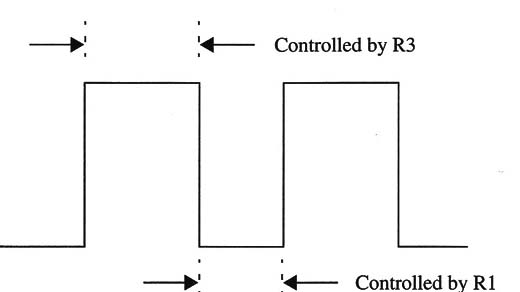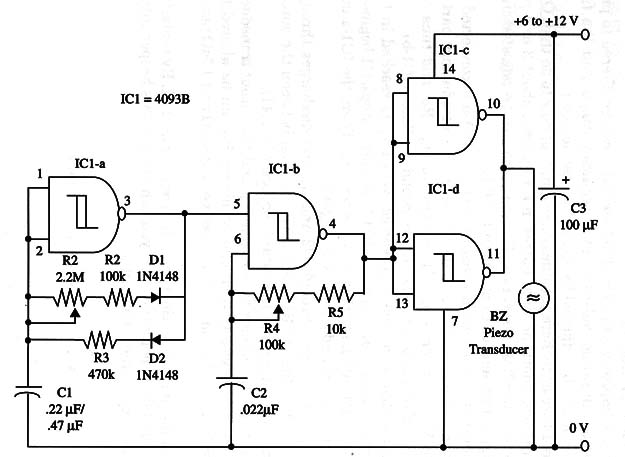With some improvements, the 4093 oscillator can be altered to produce constant-duration pulses in any frequency range, and the frequency range can be adjusted by a simple potentiometer.
The circuit we show here provides an example of how to do that. Our beeper produces short (or long) pulses in a rate from about 3 or 4 per second to one per 3 or 4 seconds.
The tone also can be adjusted in a wide range of frequencies from 100 to 1,000 Hz.
The operation of the circuit is easy to explain. ICl-a is connected as an inverter and will oscillate as described in other articles in this site.
When power is on, C1 charges through R3, and thus the high output of this gate triggers on the second oscillator (IC1-b).
During C1 charge, a tone is produced. When Vp is reached in C3, IC1-a output goes low, and then the IC 1-b oscillator stops.
C1 begins to discharge via R1, R2, and D1 until Vn is reached. Then, the IC1-a output goes high again, and a new cycle begins.
Note that C1 charges through D2 and R3 and discharges through
R1, R2, and D2. Thus, as R1 controls the interval between the output high pulses, R3 determines their duration (see Fig. 1).

Potentiometer R4 adjusts tone frequency, and the output transducer is a piezoelectric device or a crystal earphone. R3 can be altered for shorter or longer pulses in the range between 100 kg and 1 Mohm (audio pulses).
A schematic diagram of the beeper is given in Fig. 2.

By replacing X1 with a 10,000 ohm potentiometer, you can convert this beeper into a variable duty cycle audio generator.
IC1 - 4093 CMOS integrated circuit
X1 - Piezoelectric transducer or crystal earphone, Radio Shack 27 3-073 or equivalent.
D1, D2 - 1N4148 general purpose silicon diodes
R1 - 2,200,000 ohm - potentiometer
R2 - 100,000 ohm, 1/4 W, 5% resistor
R3 - 470,000 ohm, 1/4 W, 5% resistor
R4 - 100,000 ohm potentiometer
C1 - 0.22 µF or 0.47 µF ceramic or metal film capacitor
C2 - 0.022 µF ceramic or metal film capacitor
C3 - 100 µF, 16 WVDC electrolytic capacitor




